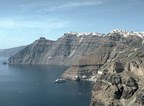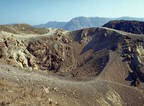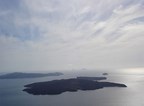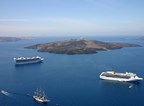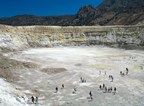Greek volcanoes are a part of “Aegean Volcanic Arc” that is been caused by sub-duction of African tectonic plate in Eurasian plate. The most popular volcano in Greece is located near Santorini Island. Most current volcanic eruption of Greece was Santorini at 1950. Greece has over 752 hot springs that are famous tourist locations. Greece has the well known volcanic arcs all over the world that was made by sinking of African lithosphere under Eurasiatic plate. Greek volcanic with the intense volcanic action in past is liable for formation of some very impressive as well as many times the eerie volcanic landscapes, which we come over in a lot of regions throughout the Greece. Very important volcanoes Greece are located at Methana, on Milos, on Santorini, on islet of Gyali, on Nisyros, as well as on Kos, with most popular being one at Milos & Santorini that get many visitors all over the year. At Santorini enchanting caldera is biggest in this world, with height of over 300m as well as diameter of 11km, when at Milos volcano in Fyriplakes is over 220m high as well as has the diameter of 1.700m. We can encounter the biggest calderas in world at Nisyros at the height of 650m as well as diameter of 3.000m, whereas height of volcano at Methana is 417m and diameter 150m.
Over 1640BC volcano of the Santorini island destroyed the European high cultures – Minoans. According to mythology this island is connected with sunken island of the “Atlantis”. Then in 230BC eruption of Methana-Volcano close to Athens was been described by ancient writers Ovid, Strabon an Pausanias. Greece was the place of active volcanoes as well as the perfect place to study them. Eruptions of the Santorini island till 1950 attracted a lot of geologists and today there are a lot of research projects that are going on. The earthquakes are frequent currently at Nisyros volcano. Two more quakes of the magnitude 2.1 & 3.1 have occurred now close to island in depths of around ten and twenty km, respectively. The molten rock is pooling under Greece’s Santorini volcano, site of the biggest eruptions in past 10,000 years. This eruption that happened around 3,600 years before, wiped out Minoan civilization of Greek islands as well as have spawned legend of lost city in Atlantis.
In past 1.5 years, magma chamber beneath volcanic island has actually ballooned by 350 million cubic feet, or 15 times of size of the London’s Olympic Stadium. The huge mass of the magma has caused this island to actually rise by around 5.5inches (over 14 centimeters), and according to the new study to be published at Sunday in journal Nature Geoscience. The research follows the reports earlier in a year of known earthquake activity under volcano after it was silent for 25 years or so. Reports have also spurred concerns volcano can erupt in a near future, however when this may happen is unclear, the researchers said in the statement. Before the work, we did not actually know how volcano behaved during periods of time in eruptions. It now looks as although magma chambers under the volcanoes such as Santorini grow in the spurts.” When the volcano erupted at about 1620B.C., it made the tsunamis 40feet (12meters) tall, which destroyed much of civilization flourishing around Aegean Sea. A lot of previous island of the Santorini was submerged or destroyed. From air, resulting caldera, and volcanic crater, seems as the small cluster in bigger collection of the Greek islands in an Aegean Sea.
Recently, Global positioning system sensors placed in caldera have detected movement, measuring the series of the small earthquakes. The seismic activity will trigger the eruptions as well as are the clue that volcano might be preparing outburst in a near future. However, connection is well understood; as well as in past some months, the seismic activity has also dropped off again, all according to a statement. Suppose volcano did erupt, then it will not be possible to make as much havoc like it did in time of Minoans, as it is smaller today than in past. However, it is still very important to keep the eye on volcano, researchers warn.
Though Santorini is known for the big explosive eruptions, probably these happen each 20,000 years and so. There is a lot of speculation as whether Santorini eruption has inspired legend of the Atlantis that Plato said drowned in ocean. Though some professionals think legend of the Atlantis was invented, and others say explosion may have given a rise to tale of the lost empire just by wiping out real life of Minoan civilization, which thrived once in Mediterranean. Greek islands in Santorini, site of history’s colossal volcanic eruptions, now are rumbling again.
As January 2011, the earthquakes have shaken landscape and Santorini volcano’s surface also has lifted by around 140 millimeters —likely because the magma is now rising from deep & filling underground chamber, the scientists report in upcoming Geophysical Letters. It is very far from whether Santorini can erupt, researchers say. Even though it does, eruption will not be anything just like infamous blast, which happened over 1600B.C, the geophysicist at Georgia Institute of the Technology Atlanta. This eruption showered the ash over eastern Mediterranean, likely contributing to decline of Minoan civilization as well as giving the rise to legend of lost city in Atlantis. Suppose Santorini erupts, it can probably be the small eruption like one seen there over past some years, recently at 1950. The eruptions have also built up pair of the islands in center of now drowned remains of volcano.
The newman & his colleagues, which includes many University of Patras Greece, started studying Santorini at 2006. They also set out the Global Positioning System stations, which precisely monitor small movements in surface as well as will capture volcano inflating like taking the deep breath. Landscape moved very barely at all till 2011, while suddenly awoke.
